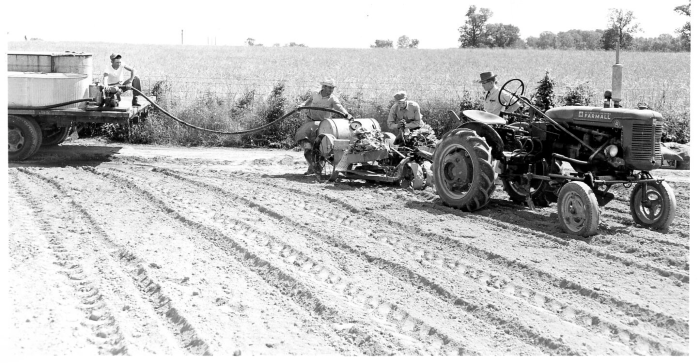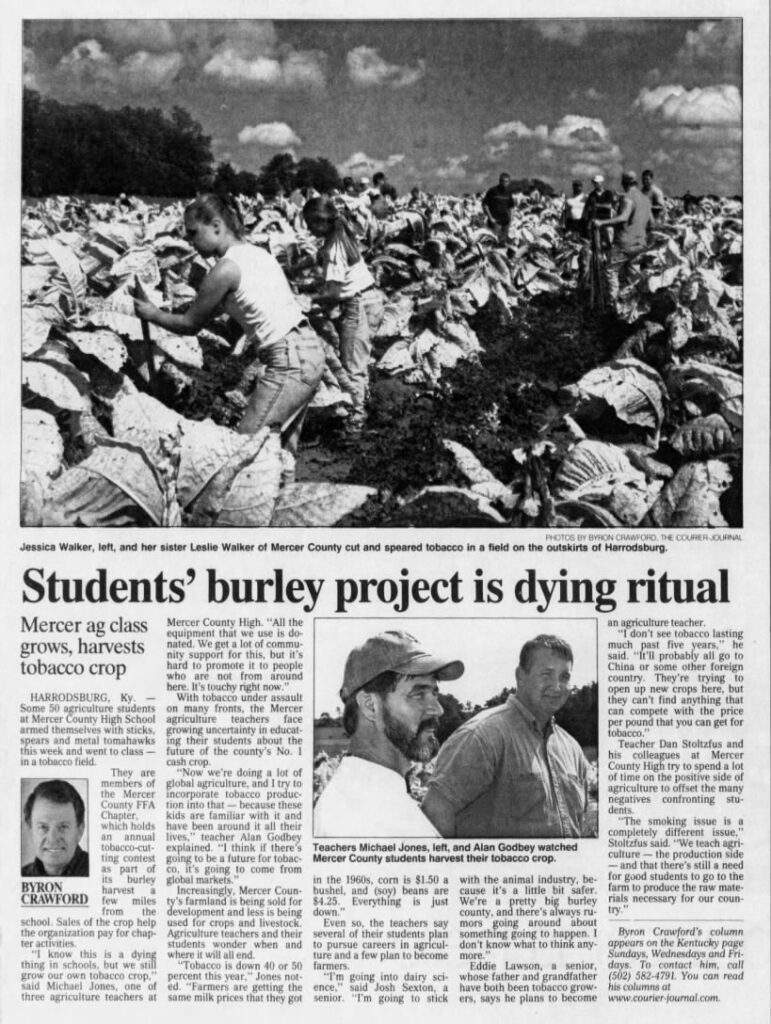We have a guest columnist this Friday. He is Matt Chaliff, Agricultural Education Consultant/FFA Executive Secretary in Kentucky. I am sure the readers will get an education about tobacco and vocational agriculture in Kentucky just like I did. Take it away Matt.
In the years following the Civil War, tobacco became Kentucky’s leading cash crop, a position it held until the early years of the 21st century. Burley tobacco was grown in eastern and central Kentucky while dark fire cured and dark air cured tobacco were grown in the western part of the state. With tobacco playing such an important role in the agriculture industry, it was only natural that it became an integral part of agricultural education in the state.
Tobacco production was an important part of the vocational agriculture curriculum across the state from 1917 moving forward. According to Dr. Charles Byers, most teachers included basic tobacco production lessons in Ag I courses offered to freshman students. Vo Ag boys in the 1960’s would have spent their days solving problems such as “How should we select a variety of tobacco to grow?” and “How do we control suckers in burley tobacco?” during their freshman year. Most teachers taught lessons about harvesting, stripping, and marketing tobacco during the fall semester of their Ag II courses. Nearly every boy in the class would have a tobacco crop at home so the lessons were very pertinent. Many advancements in tobacco production were driven forward by agriculture students going home and telling their parents what they learned at school.
Enterprising agriculture teachers were quick to seize opportunities related to changes in tobacco production. In the early 1980’s the market changed from tobacco being sold in hands to being sold in 60-80 pound bales. Agriculture shops built the vast majority of tobacco baler boxes across the state and most of these were in use for the next 20 years. Around 1990, the industry switched from growing tobacco transplants in plant beds to using “float plants” produced in water beds. Many school greenhouses were used to produce transplants for specific farmers in the community at a pre-determined price.

Figure 1. Future National FFA Eastern Region Vice President Gracie Furnish of Harrison County with tobacco float plants in 2015
Tobacco became a major part of Supervised Agricultural Experience Programs across the state. Many boys (and later girls) got their start in farming by helping parents or grandparents grow tobacco for a share of the profits at the end of the season. The tobacco price support system allowed young farmers to lease tobacco quota from older landowners and beginners could trade labor with relatives and neighbors for use of equipment and help during the busy times of year.
 Figure 2. Bill Franklin of the Lewisburg, KY FFA inspects his tobacco SAE project. Photo from the 1950s.
Figure 2. Bill Franklin of the Lewisburg, KY FFA inspects his tobacco SAE project. Photo from the 1950s.
With so much emphasis on tobacco in classroom instruction and SAEP, it was only natural that tobacco became part of FFA as well. Tobacco production awards were a staple in many chapters with inputs being carefully documented and end of season yields being measured by agriculture teachers and county agents. A tobacco grading contest and a tobacco auctioneering contest were held at the Kentucky State Fair each year from the 1950’s through the end of the federal tobacco program in 2004. Several FFA regions held tobacco field days in cooperation with tobacco sales warehouses, with tobacco stripping and grading contests being the main attractions. Nearly every Kentucky Star Farmer from 1944 through 2005 grew some tobacco as part of their program and the Specialty Crop proficiency was one of the most competitive contests in the state for many years.

Figure 3. 1954 Star Farmer Ken Reed of Versailles with his father and advisor C. O. Neal.
While this may be surprising to people from other parts of the country, it was fairly common for agriculture programs to grow tobacco as both a learning experience for students and a fundraiser for the FFA chapter. In many instances, the county school district owned a tobacco quota that came with a farm purchased to build a new high school. The district allowed the agriculture program to grow the crop at little or no cost.
Retired Bourbon County teacher Jim Cleaver recalled that tobacco was first grown on campus at Bourbon County around 1980. His successor Andrew Fritsch reported that tobacco was grown by the chapter on a variety of local farms through 2015. The crop varied from 2-6 acres depending on a variety of factors and all work was performed by students. According to Fritsch, “The kids set it, plowed it, chopped it out (which they hated), topped, cut, housed and stripped it. You should see what 60 kids in a tobacco barn looks like! One year we housed 6 acres by 1:00 that afternoon Then of course we stripped it in the shop. All classes were involved.
We got parents to sign a permission form for their child to be able to work in the tobacco. We would have somewhere around 60-80 kids in the shop at one time stripping. It was pretty hard to keep them in line, because you never knew what some vagrant kid would do. One time Philip Morris sent me an ag mechanics book that was inside a bale of tobacco. They weren’t real happy about that.” Due to health concerns about tobacco and liability concerns about students being involved in production, schools began to move away from growing tobacco in the early 2000’s. Bourbon County was one of the last if not the last schools in the state to grow the crop.

Figure 4. The Courier-Journal (Louisville), September 22,2000.
With the end of the federal tobacco program in 2004, tobacco production began a major shift. Tobacco companies wanted to work with fewer and larger farming operations and the days of a young farmer growing an acre of tobacco “on the shares” with a neighbor soon came to an end. Today, much less tobacco is grown in the Bluegrass state and production has shifted to the west. A few larger operations grow most of the crop and utilize H-2-A workers to produce the labor intensive crop.
Curator’s Comments
While there are many commonalities in agricultural education programs across the country, there are also some unique differences. At some point in my teaching career I became aware that some schools in Kentucky had tobacco allotments. Now I know more about this thanks to Matt.
